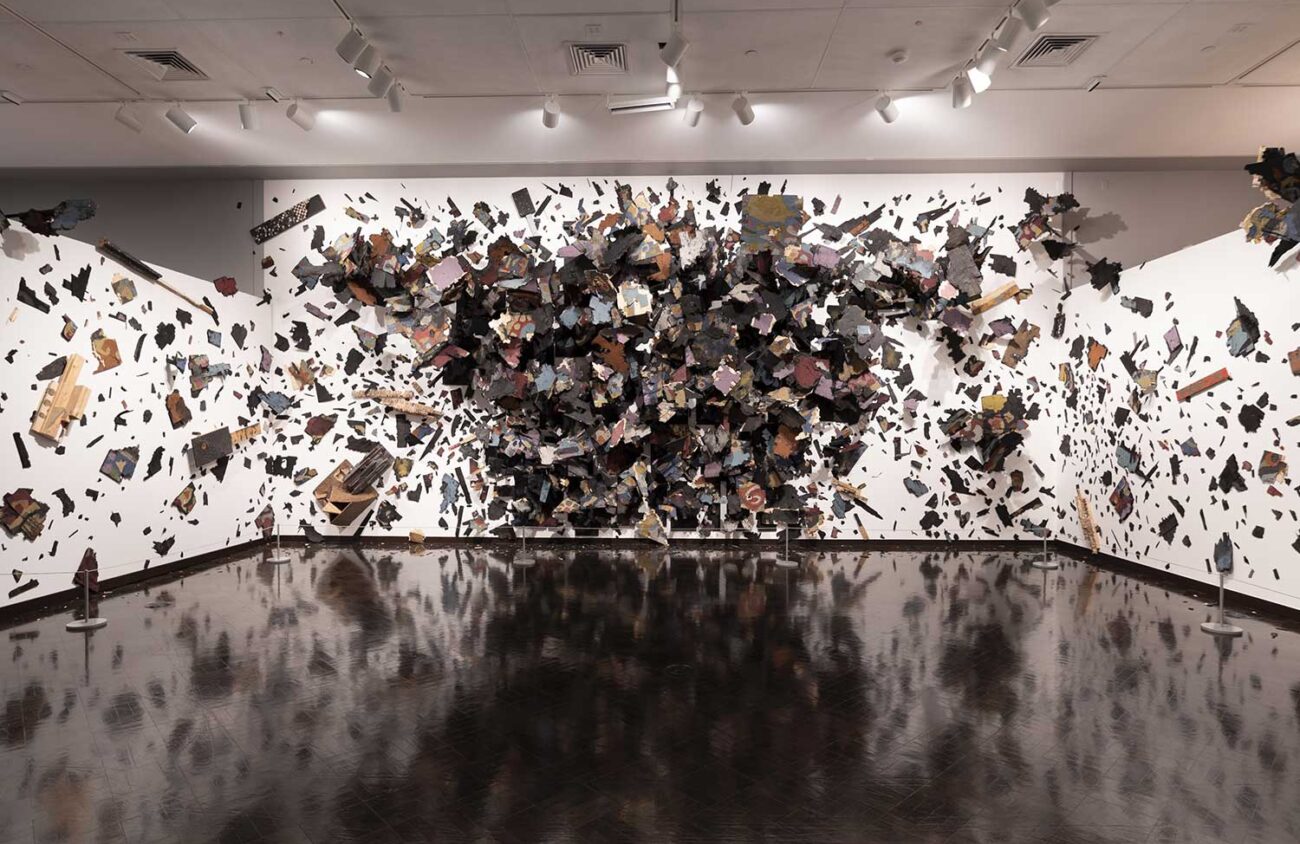“By and by all trace is gone, and what is forgotten is not only the footprints but the water, too, and what is down there. The rest is weather.” This is a quote by author Toni Morrison that Rachel Nelson chose to include in the exhibition statement for Strange Weather, a group show she and Jennifer Gonzalez co-curated at the Jordan Schnitzer Museum of Art. It runs in the museum’s Barker Gallery through April 7.
Authors and poets have traditionally referenced nature to speak of the eternal, or at least that which lasts longer than human life. But facing global warming, we need to reconsider. The strange new reality is that nature, or the weather, might be as temporal as our own existence.
Consequences of human interference are related to the themes around which this show revolves. The artists are a diverse group in terms of their cultures and stylistic approach, and were chosen by Gonzalez and Nelson to address the show’s themes: climate change and the effects of colonialism on Indigenous people and their lands.
The artists are both well known and up-and-coming. They include Carlos Almarez, Carlos Amorales, Leonardo Drew, Joe Feddersen and Hock E Aye Vi Edgar Heap of Birds as well as James Lavadour, Nicola Lopez, Hung Liu, Julie Mehretu and Wendy Red Star. In addition, there’s Alison Saar, Lorna Simpson, Kiki Smith, Charles Wilbert White, Kehinde Wiley and Terry Winters.
Without a doubt, the most overwhelming art in the show is Drew’s installation “Number 215B.” It is a massive work that occupies an entire room in the gallery. Composed of wood shards adhered to the wall and even to the floor, it is a work of art that’s designed to resemble an explosion. Standing in the room, it seems as if the whole piece is blowing apart before your eyes.
The curators chose all the art from the Jordan Schnitzer Collection and Jordan Schnitzer Family Foundation. That’s a collection of more than 20,000 pieces, and with its focus on contemporary art and artists of color, it served as a terrific resource for the themes of Strange Weather.
Gonzalez says they were told, “Feel free to choose any art you want.”
She and Nelson selected the grand-scale installation, but also works on paper (Schnitzer is known for having one of the nation’s largest print collections), oil paintings and a bronze sculpture by Saar called “Grow’d.”
“Number 215B” is installed at one end of the large gallery, and “Grow’d” sits at the opposite side. It is a life-sized portrayal of Topsy, the young enslaved girl from the novel Uncle Tom’s Cabin. Saar cast the figure in bronze, yet it seems delicate, as the figure’s hair defies gravity. It grows up like the branches of a tree — a cotton tree. Each of her braids is tied to cotton, as is the character herself.
Saar gives the fictional Topsy the appearance of wearing a crown made of branches, and the effect transforms the character from her enslaved station to a regal position sitting on her bronzed bale seat, as if holding court for all who pass before her.
“Official Portraits: Citizen” and “Official Portraits: Proletarian” are contributions by Liu (1948-2021). They are prints with collage. Liu, like Saar, chose to portray subjects who had little status in their culture. Liu’s subjects, though, were often Chinese peasants who worked in the fields. She sought to transform their low position in life by depicting them among bright fields of color. The signature drip, seen in her paintings, is absent in these prints, but the color, symbolism and flowers she uses in her portraits are all present.

Wiley paints people similarly, against intensely bright and floral grounds. You may recognize his work at once, an oil on canvas and double portrait called “Marechal Floriano Peixoto II.” That’s because Wiley rose to national recognition after painting President Barack Obama’s portrait for the National Portrait Gallery of the Smithsonian Institution. His style is highly realistic, and he places the people he paints — largely African American — among a pop background of flowers that sometimes dip into the foreground.
Wiley says he uses traditional approaches from Western art, like working with oil on canvas or appropriating known works from Western art history, to create portraits of people who have traditionally been left out of the picture.
The title Strange Weather brings to mind changes in climate that may not be adaptable to the human species. It’s a heavy framework for an art show, yet the work itself, no matter how serious the subtext, is alternately light and surprising. Drew explains his process in the museum’s “Gallery Guide.” The distressed-looking wood pieces in his art were not found that way. He created the appearance of damage or age by a variety of processes, including burning and oxidation.
“I become the weather,” he says.
